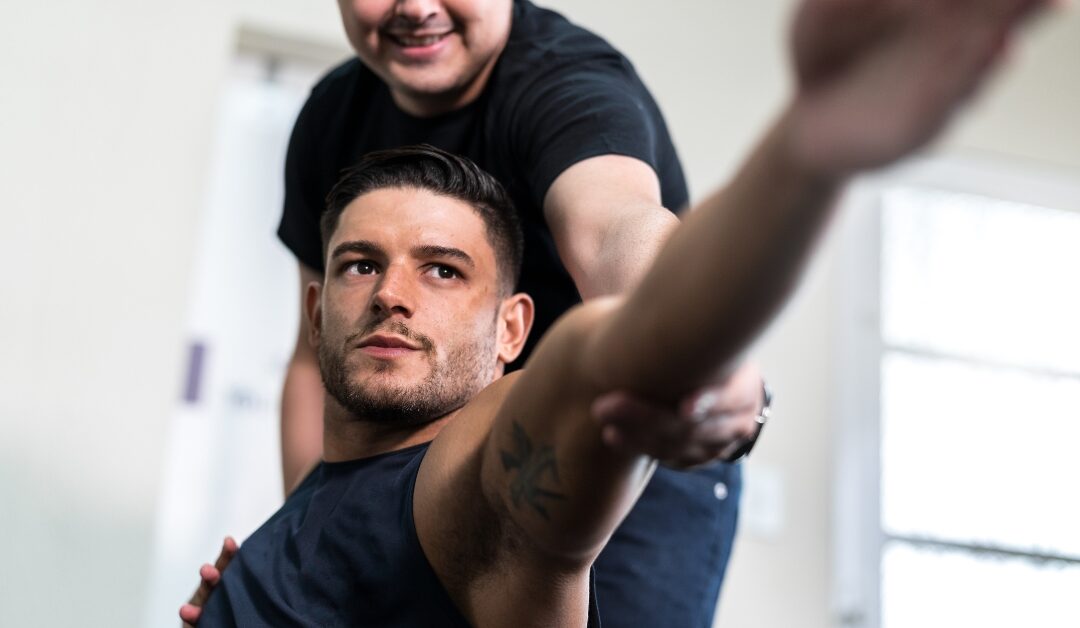Shoulder pain can be frustrating, especially if it limits your ability to work out at full capacity. Addressing a shoulder injury promptly can prevent further complications and help you get back to lifting heavy weights. If you experience pain when lifting laterally, struggle to lift as heavy as you want, and need to be mindful of your workout angles, this guide is for you.
We’ll break down the potential causes of your discomfort, adjustments you can make, and exercises to strengthen your shoulder while minimizing pain.
Why Does My Shoulder Hurt When Lifting Laterally?
Lateral movements, such as lateral raises or overhead presses, place significant strain on the shoulder joint, particularly the rotator cuff and deltoid muscles. Pain in these movements can result from:
- Rotator Cuff Strain, Impingement, or Tears: The rotator cuff is responsible for stabilizing the shoulder joint. If the tendons become inflamed, impinged, or torn, it can lead to pain, especially at specific angles.
- Labral Irritation or Tear: The labrum is the cartilage that helps keep the shoulder socket stable. If it’s irritated or torn, certain movements may cause discomfort.
- AC Joint Stress: The acromioclavicular (AC) joint, located at the top of the shoulder, can become irritated with heavy lateral movements.
- Poor Shoulder Mechanics and Weak Scapular Stability: Improper movement patterns or weak stabilizing muscles can place excessive stress on the shoulder joint, leading to pain.
Physical therapists play a crucial role in diagnosing these issues and developing personalized treatment plans to alleviate pain and restore function.
Key Adjustments for Shoulder Pain Relief While Lifting
If you’re dealing with shoulder pain, you don’t necessarily have to stop lifting altogether. Making these small but effective modifications can keep you in the gym while protecting your shoulder: Incorporating physical therapy treatments can also be beneficial in managing shoulder pain and improving overall shoulder health.
1. Adjust Your Workout Angles
Instead of performing strict lateral raises with arms fully extended at 90 degrees, try these alternatives:
- Perform lateral raises at a slight forward angle (scapular plane, about 30 degrees forward) to reduce stress on the rotator cuff and shoulder muscles.
- Avoid raising above shoulder height, as excessive elevation can contribute to impingement.
- Instead of heavy overhead pressing, opt for landmine presses, which allow for a more natural movement pattern and reduce joint strain. This adjustment can also help prevent strain on the upper arm, reducing the risk of further injury.
If your shoulder pain persists, don’t ignore it—get assessed by a professional to prevent long-term issues. Seeking professional help can ensure that your injured shoulder is properly treated and rehabilitated.
Want to lift pain-free? Schedule a free discovery call with Green Physical Therapy today!
2. Reduce Load and Increase Reps
If you experience discomfort when lifting heavy, lighten the weight and focus on higher reps (12-20) with controlled movement. This reduces strain while still providing muscle stimulation.
Incorporating physical therapy exercises into your routine can also help strengthen the shoulder and prevent future injuries.
3. Optimize Grip and Wrist Position
For overhead presses or dumbbell work, try a neutral grip (palms facing inward) to reduce shoulder joint compression.
Strengthen Rotator Cuff Muscles
Improving scapular and rotator cuff stability, as well as the muscles surrounding the shoulder, is key to long-term shoulder health. Add these exercises to your routine:
- Face Pulls – Strengthens the rear delts and rotator cuff.
- Scapular Retraction Drills – Improves shoulder blade positioning.
- External Rotations with a Band – Builds rotator cuff strength.
- Wall Slides or Y-T-Ws – Enhances shoulder mobility and stability.
Incorporating shoulder physical therapy can further enhance these muscles and improve overall shoulder function.

Best Exercises for Shoulder Strength Without Pain
If traditional movements cause discomfort, try these pain-free alternatives:
These exercises are designed to relieve shoulder pain while still allowing you to build strength. Incorporating physical therapy exercises can further enhance shoulder strength and mobility.
1. Landmine Press
A safer alternative to traditional overhead pressing, this movement supports the shoulder joint while allowing for progressive loading.
2. Cable Lateral Raises (With a Slight Lean)
This modification keeps tension on the delts while reducing stress on the joint.
3. Seated Dumbbell Shoulder Press (Neutral Grip)
Seated variations provide more stability and control, while a neutral grip reduces impingement risk.
4. Reverse Flys
Strengthens the posterior delts and scapular stabilizers to improve shoulder mechanics.
5. Scapular Wall Slides
A great mobility drill to keep your shoulders moving properly.
When to Seek Professional Help
If you experience:
- Persistent pain that doesn’t improve with modifications
- Sharp or radiating pain down the arm
- Limited range of motion
- Weakness or instability in the shoulder
Understanding the nature of shoulder injuries is crucial for effective treatment and recovery.
It’s time to consult a physical therapist. At Green Physical Therapy, we specialize in helping athletes and active individuals get back to lifting pain-free. Our evidence-based approach focuses on a physical therapist’s evaluation, mobility, strength, and technique correction to keep you moving at your best.
Final Thoughts
Shoulder pain doesn’t have to keep you from training hard. Pain in the shoulder can often radiate to the upper arm bone, affecting overall arm function. By making small adjustments to your technique, strengthening key stabilizing muscles, and listening to your body, you can continue making progress while keeping your shoulders healthy.
If your shoulder pain persists, don’t ignore it—get assessed by a professional to prevent long-term issues. Seeking professional help can ensure that your injured shoulder is properly treated and rehabilitated.
Want to lift pain-free? Schedule a free discovery call with Green Physical Therapy today!

